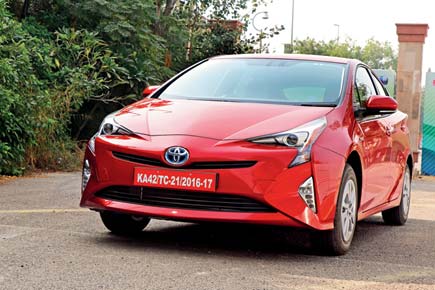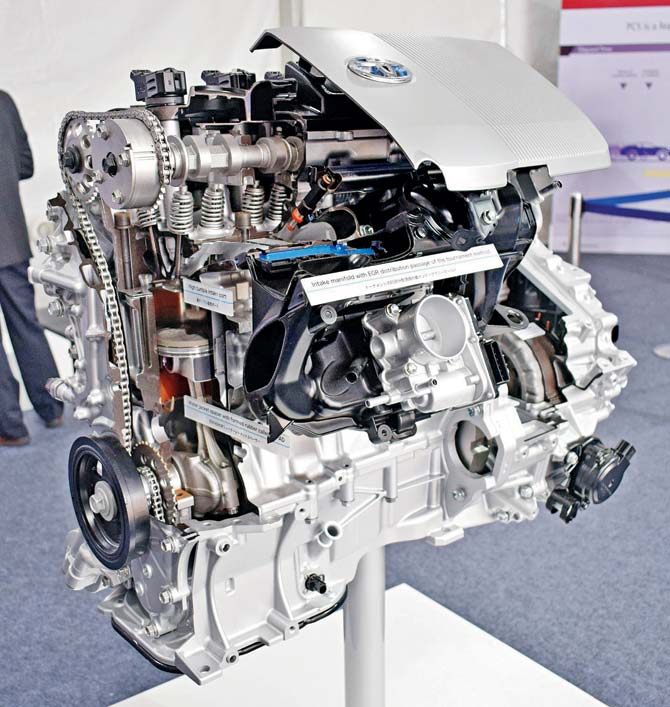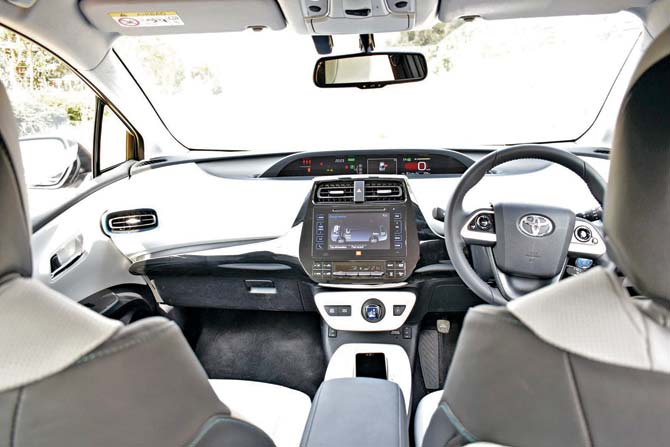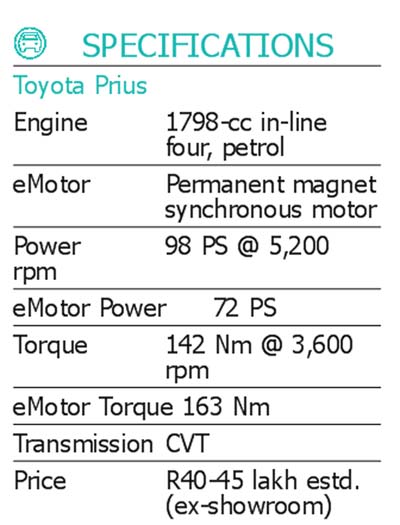The green brigade has further reason to rejoice as Toyota is all set to launch the futuristic and stylish fourth-generation Prius in India


The Toyota Prius is the poster car that graces the walls of nature-lovers all over the world. Now in its fourth generation, this best-selling hybrid car in the world has evolved to become more stylish. The whole stubby silhouette of the older car has given way to a sleeker and futuristic shape that is lower, wider and longer than before. The back end doesn’t really rise as sharply as before, giving the new Prius a more coupé-like look. Besides, the drag coefficient has gone down from 0.25 Cd to 0.24 Cd, which makes it one of the most aerodynamic cars.
ADVERTISEMENT

The Atkinson Cycle 1.8-litre petrol engine is now better than ever before
The cherry on the top are the headlamp and tail-lamp units. Instead of just sticking a pair of lights on either end, Toyota designers chose to integrate the lights within the design of the front and rear itself. Now, that is clever designing; something which might become the norm in the future when aerodynamics will be as necessary as fuel-efficiency.
Inside, the old drab dashboard has given way to a sleeker and sassier looking unit that goes well with the whole theme of the car. It was the quality of the interior that impressed us the most. The soft-touch plastics are great and the overall feel is pretty rich. Space is also quite good thanks to the new platform that has liberated more space inside the car; especially the boot, which is now almost 100 litres bigger than its predecessor.

New platform has improved interior space levels. Pics/Toyota
However, the true master stroke lies under that body, which hides the new Toyota Next Global Architecture (TNGA). The Prius now enjoys the privilege of being the first car in the company’s line-up to be based on this versatile new platform. It brings a stronger structure with improved rigidity, new double-wishbone independent rear suspension and lower centre of gravity.
The 1.8-litre, in-line four-cylinder petrol engine based on Atkinson’s cycle still produces 96 PS and 142 Nm of torque. However, with a new intake port, the airflow to the combustion chamber has been improved. Thermal efficiency and the overall fuel consumption has also been improved. Toyota says that despite the same power and torque figures of the gasoline engine, the overall performance has improved thanks to the new battery pack, motors and improved CVT.
The electric drivetrain has been updated with the motor, battery and other components now being lighter and compact. The two motor-generators are all new and they are designed to suit the new multi-shaft trans-axle setup of the Prius. Batteries have been re-designed, making them slimmer, and are relocated under the rear seats, resulting in more boot space. Toyota offers the new car with either nickel-metal hydride or lithium-ion battery packs and we believe that the Indian model will come with the former.

The old dashboard is replaced by a sassy unit
The engine comes to life by pressing the start-stop button. The Prius starts in ‘Normal’ mode, which engages the electric motors to propel forward. This mode senses the use of the throttle and then swaps between electric and petrol power. There are three other modes as well; EV, Eco and Power. The EV mode is completely electric. However, due to battery limitations, this mode can power the car only for a few kilometres. While the Eco mode works like the Normal mode, with reduced response from the engine, the Power mode lets you enjoy the most of the motor.
The initial impression is similar to that of an electric car. There is no sound, instead, the console informs you that you are ready to go. Step on the throttle gently and it starts rolling smoothly. We floored the throttle to see how the Prius behaved and the first thing we noticed was the engine kicking in with a faint noise.
The refinement of Toyota’s Hybrid Synergy Drive system is phenomenal. The transition from electric to petrol power was seamless.
In terms of fuel efficiency, the new Prius promises an unbelievable 40 km/l, according to Toyota. The emission levels of the new Prius stand at 70 g/km of CO2, which is 19 g/km less than its predecessor. There is no doubt that the new Prius is fuel-efficient and greener than before.

The handling is sublime as it can corner well without making the occupants nervous. Stability, body-control, and steering have been improved to make the new Prius good at handling a variety of conditions. The independent suspension also does its job perfectly, keeping body-roll at bay while providing a good ride quality.
The new Prius is safer with a host of safety features that comes standard, including traction control, blind-spot monitoring, HUD, and stability control. Braking is good as well with ample feel, feedback and bite.
Overall, our short drive proved us that this car is a well-balanced city car. But in order to own one, you’ll have to wait for some time because Toyota is yet to launch the car in India. We expect the company to announce the Prius before the end of the financial year and we expect it to be priced around R40–45 lakh (ex-showroom), which will be more costlier. But for a new platform and more technology, we feel it’s worth it.
 Subscribe today by clicking the link and stay updated with the latest news!" Click here!
Subscribe today by clicking the link and stay updated with the latest news!" Click here!







